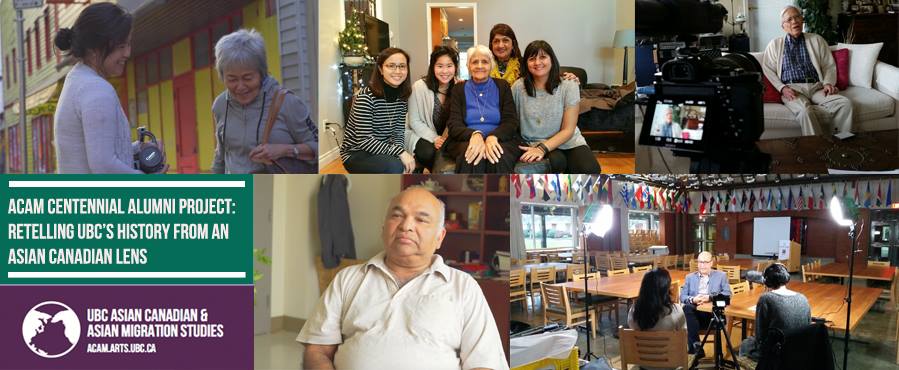This year marks UBC’s 100th year in the making. To celebrate this special achievement, UBC’s Asian Canadian and Asian Migration Studies, a multidisciplinary program that explores the history, culture, and contemporary development of Asian communities in Canada, and global Asian migrations (or simply “ACAM“), decided to create a centennial alumni project to reveal the untold stories of UBC’s Asian Canadian students and communities. Although it has only been two years since the start of the ACAM program, ACAM has been fearless and daring, taking on a lengthy, complex project that not only sparks, but also binds the community together stronger than ever. I interviewed Dr. Chris Lee, director of the ACAM program, and Dominique Bautista, a member of the first graduating class of ACAM and primary researcher/ producer of the project, to explore the early beginnings and future of the ACAM program, as well as uncovering the process and motivations for such a unique initiative.

Credits to Asian Canadian and Asian Migration Studies UBC
The Asian Canadian and Asian Migration Studies program began in 2014, essentially driven by a small group of students and a few members of the UBC Arts faculty.
“When we got started two years ago, we were just trying to put things together and get things coordinated. [Students] saw the growing pains of the program,” Lee remarked.
It was also another reason for the program to have a bigger sense of student community. Students of ACAM described the program as a tight- knit family, where the people you work with academically and professionally are also the people you can call and have dim sum with. (Bautista shared with me that she had dim-sum with an 105 year old elder in the Asian-Canadian community who is also her mentor.) The first graduating class had four students, while this year’s class with six graduates. Currently, there are fifteen students enrolled in the program.
“It takes time to build up, [and] start getting courses out,” he shared.
However, in just two short years, the ACAM program has provided concrete ways for students to serve, build, and connect with the community, such as boldly taking on the ACAM Centennial project.
UBC is known for having a very large Asian population (a common and international joke about the university is calling it “University of a Billion Chinese”); however, as Bautista shared, “we know UBC’s history, but it may not be in a non-Asian perspective.” In UBC’s student registries from 1916, UBC wasn’t always assumed to being too Asian.
“So how did we get from there to here?” Bautista asked.
To explore this question, Bautista decided to research further, looking at the different oral histories of the first Asian Canadian students’ experiences on campus. She started looking through student and club photos in “The Totem” and “The Annual”, yearbooks UBC used to produce until 1966, but are now digitized and available online for viewing.
“Looking at every single face for Asian features, [and] if they had [them], I would write down their names, then put [those names] into a spreadsheet,” she shared. She would then try to find contact information for these people, reaching out to staff members in the arts alumni office, people of the archives, and even community members to get more help on contacting these unknown students.
“Our technology takes us so far, but it’s still that traditional word of mouth that’s really important, especially in cultures where we’re looking at [previous UBC alumni] who don’t engage with the internet,” she commented.
After spending a year on researching, she produced five video vignettes, edited by Alejandro Yoshizawa and with the help of the ACAM community, (which are out now; a link is included below) to share the important conversations she had with UBC’s community.
The future is very bright for the ACAM program, especially as it functions in a place that cultivates strong and vocal leaders. These leaders “serve diverse roles, are intentional to build opportunities for student work in the community, and create knowledge together,” Lee stated. The program is a space for developing passionate students who want to explore their own Asian Canadian identities within our community. For Bautista, she was originally set on completing a major in English Literature and a minor in Sociology. Many of the courses she took aligned with the ACAM minor requirements (another key feature of the program), so she could have graduated with a double minor. However, UBC does not allow double minors, so she had to make a crucial choice.
She shared, “ACAM was too important for me to just not do. But what really drew me in was the opportunity to study issues relevant to my own exploration of identity because as someone who grew up [in Vancouver], my family lives in Manila and my great grandparents are from China.” Now, Bautista is a graduate who continues to work with the Asian-Canadian community, specifically at ACAM.
Dr. Chris Lee ended off our conversation by telling me that “it’s a really good time for ACAM”. In fact, I think it’s a really good time for Asian Canadians too.
The ACAM Centennial Project is now available and can be viewed here: http://acam.arts.ubc.ca/acam-centennial-alumni-project/. For more information on the program, please visit http://acam.arts.ubc.ca/